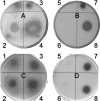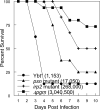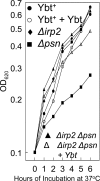The yersiniabactin transport system is critical for the pathogenesis of bubonic and pneumonic plague
- PMID: 20160020
- PMCID: PMC2863531
- DOI: 10.1128/IAI.01236-09
The yersiniabactin transport system is critical for the pathogenesis of bubonic and pneumonic plague
Abstract
Iron acquisition from the host is an important step in the pathogenic process. While Yersinia pestis has multiple iron transporters, the yersiniabactin (Ybt) siderophore-dependent system plays a major role in iron acquisition in vitro and in vivo. In this study, we determined that the Ybt system is required for the use of iron bound by transferrin and lactoferrin and examined the importance of the Ybt system for virulence in mouse models of bubonic and pneumonic plague. Y. pestis mutants unable to either transport Ybt or synthesize the siderophore were both essentially avirulent via subcutaneous injection (bubonic plague model). Surprisingly, via intranasal instillation (pneumonic plague model), we saw a difference in the virulence of Ybt biosynthetic and transport mutants. Ybt biosynthetic mutants displayed an approximately 24-fold-higher 50% lethal dose (LD(50)) than transport mutants. In contrast, under iron-restricted conditions in vitro, a Ybt transport mutant had a more severe growth defect than the Ybt biosynthetic mutant. Finally, a Delta pgm mutant had a greater loss of virulence than the Ybt biosynthetic mutant, indicating that the 102-kb pgm locus encodes a virulence factor, in addition to Ybt, that plays a role in the pathogenesis of pneumonic plague.
Figures




Similar articles
-
Yersiniabactin iron uptake: mechanisms and role in Yersinia pestis pathogenesis.Microbes Infect. 2011 Sep;13(10):808-17. doi: 10.1016/j.micinf.2011.04.008. Epub 2011 May 12. Microbes Infect. 2011. PMID: 21609780 Free PMC article. Review.
-
Zinc transporters YbtX and ZnuABC are required for the virulence of Yersinia pestis in bubonic and pneumonic plague in mice.Metallomics. 2017 Jun 21;9(6):757-772. doi: 10.1039/c7mt00126f. Metallomics. 2017. PMID: 28540946 Free PMC article.
-
Role of the Yersinia pestis yersiniabactin iron acquisition system in the incidence of flea-borne plague.PLoS One. 2010 Dec 17;5(12):e14379. doi: 10.1371/journal.pone.0014379. PLoS One. 2010. PMID: 21179420 Free PMC article.
-
Yersiniabactin contributes to overcoming zinc restriction during Yersinia pestis infection of mammalian and insect hosts.Proc Natl Acad Sci U S A. 2021 Nov 2;118(44):e2104073118. doi: 10.1073/pnas.2104073118. Proc Natl Acad Sci U S A. 2021. PMID: 34716262 Free PMC article.
-
The role of transition metal transporters for iron, zinc, manganese, and copper in the pathogenesis of Yersinia pestis.Metallomics. 2015 Jun;7(6):965-78. doi: 10.1039/c4mt00332b. Metallomics. 2015. PMID: 25891079 Free PMC article. Review.
Cited by
-
Shift from primary pneumonic to secondary septicemic plague by decreasing the volume of intranasal challenge with Yersinia pestis in the murine model.PLoS One. 2019 May 23;14(5):e0217440. doi: 10.1371/journal.pone.0217440. eCollection 2019. PLoS One. 2019. PMID: 31121001 Free PMC article.
-
Systematic analysis of cyclic di-GMP signalling enzymes and their role in biofilm formation and virulence in Yersinia pestis.Mol Microbiol. 2011 Jan;79(2):533-51. doi: 10.1111/j.1365-2958.2010.07470.x. Epub 2010 Dec 3. Mol Microbiol. 2011. PMID: 21219468 Free PMC article.
-
Poly-N-acetylglucosamine expression by wild-type Yersinia pestis is maximal at mammalian, not flea, temperatures.mBio. 2012 Aug 14;3(4):e00217-12. doi: 10.1128/mBio.00217-12. Print 2012. mBio. 2012. PMID: 22893384 Free PMC article.
-
TNFα and IFNγ contribute to F1/LcrV-targeted immune defense in mouse models of fully virulent pneumonic plague.Vaccine. 2010 Dec 16;29(2):357-62. doi: 10.1016/j.vaccine.2010.08.099. Epub 2010 Sep 15. Vaccine. 2010. PMID: 20840834 Free PMC article.
-
Znu is the predominant zinc importer in Yersinia pestis during in vitro growth but is not essential for virulence.Infect Immun. 2010 Dec;78(12):5163-77. doi: 10.1128/IAI.00732-10. Epub 2010 Sep 20. Infect Immun. 2010. PMID: 20855510 Free PMC article.
References
-
- Anderson, G. W., Jr., S. E. C. Leary, E. D. Williamson, R. W. Titball, S. L. Welkos, P. L. Worsham, and A. M. Friedlander. 1996. Recombinant V antigen protects mice against pneumonic and bubonic plague caused by F1-capsule-positive and -negative strains of Yersinia pestis. Infect. Immun. 64:4580-4585. - PMC - PubMed
-
- Anisimov, R., D. Brem, J. Heesemann, and A. Rakin. 2005. Molecular mechanism of YbtA-mediated transcriptional regulation of divergent overlapping promoters ybtA and irp6 of Yersinia enterocolitica. FEMS Microbiol. Lett. 250:27-32. - PubMed
Publication types
MeSH terms
Substances
Grants and funding
LinkOut - more resources
Full Text Sources
Medical
Molecular Biology Databases
Research Materials

